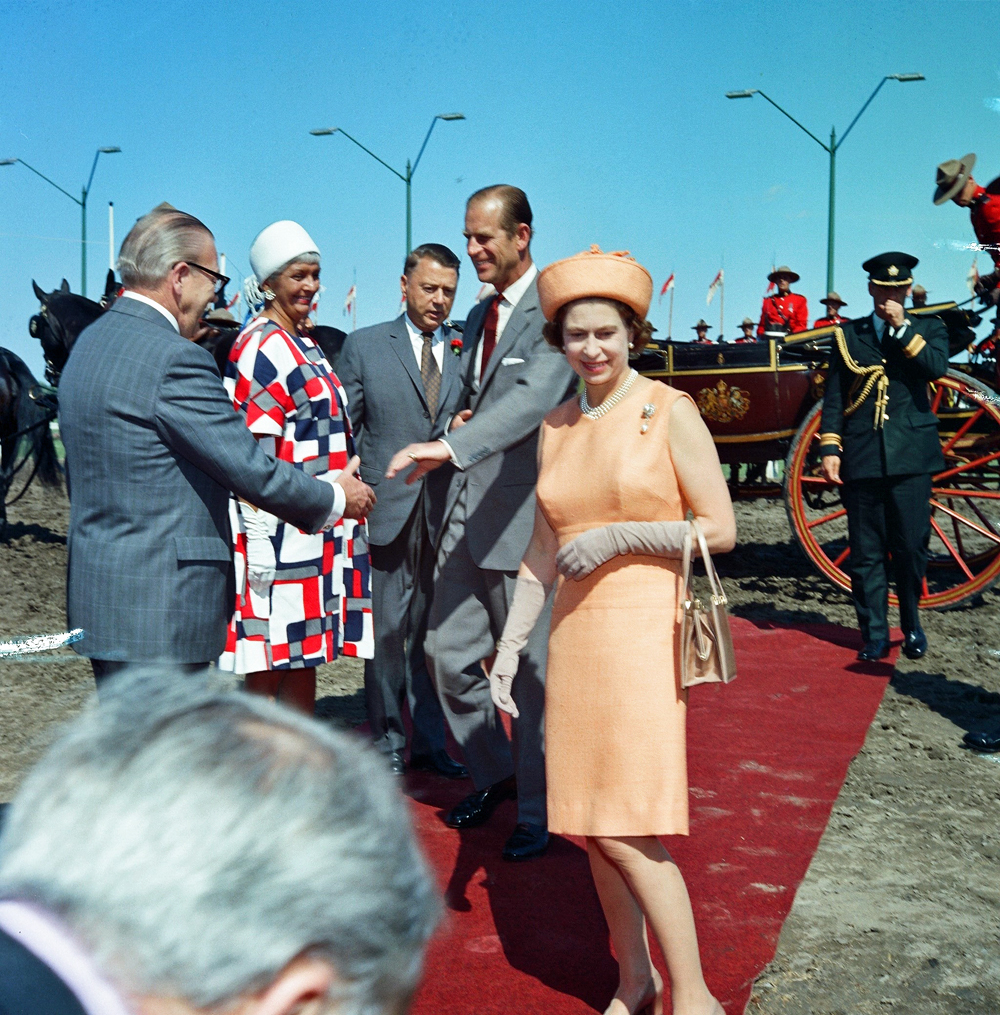
Royals arrive at Assiniboia Downs for the Manitoba Derby. July 15, 1970.
by Bob Gates
Manitoba was celebrating its centenary in 1970 and the owner of Assiniboia Downs, Jack Hardy, wasn’t about to let the occasion pass without taking full advantage.
The 22nd running of the Manitoba Derby was the marquee event of the Assiniboia Downs racing calendar and something special was in order.
You can only imagine the time, effort and organization that went into arranging a visit by Her Royal Majesty, Queen Elizabeth ll, but Jack pulled it off. The Queen, her husband, the Duke of Edinburgh, Prince Charles and Princess Anne included a trip to Assiniboia Downs as a part of their tour of the Province.

The largest Manitoba Derby crowd in history in 1970. 11,127 people!
What a day it was! The Queen raced horses and was considered an authority on thoroughbred bloodlines and breeding in Britain. Prior to 1970 there was no Derby trophy to award. The winner of the “Run for the Tartan” as it was known then, received a silver tray.
Come July 15, 1970 that was going to change. The winner of the Manitoba Derby would receive the “Queen’s Cup” which Her Majesty was donating for annual competition. If you do the math, this year’s Derby will mark the 49th time the Cup has been presented.
Of all the arrangements for the Royal visit, the most eye-catching feature had to be the Royal viewing dais from which the Queen and fellow dignitaries viewed the race. Blink however, and you would have missed it. The viewing stand was erected immediately south of the old winner’s circle just prior to Derby Day and was removed in the days following the race.
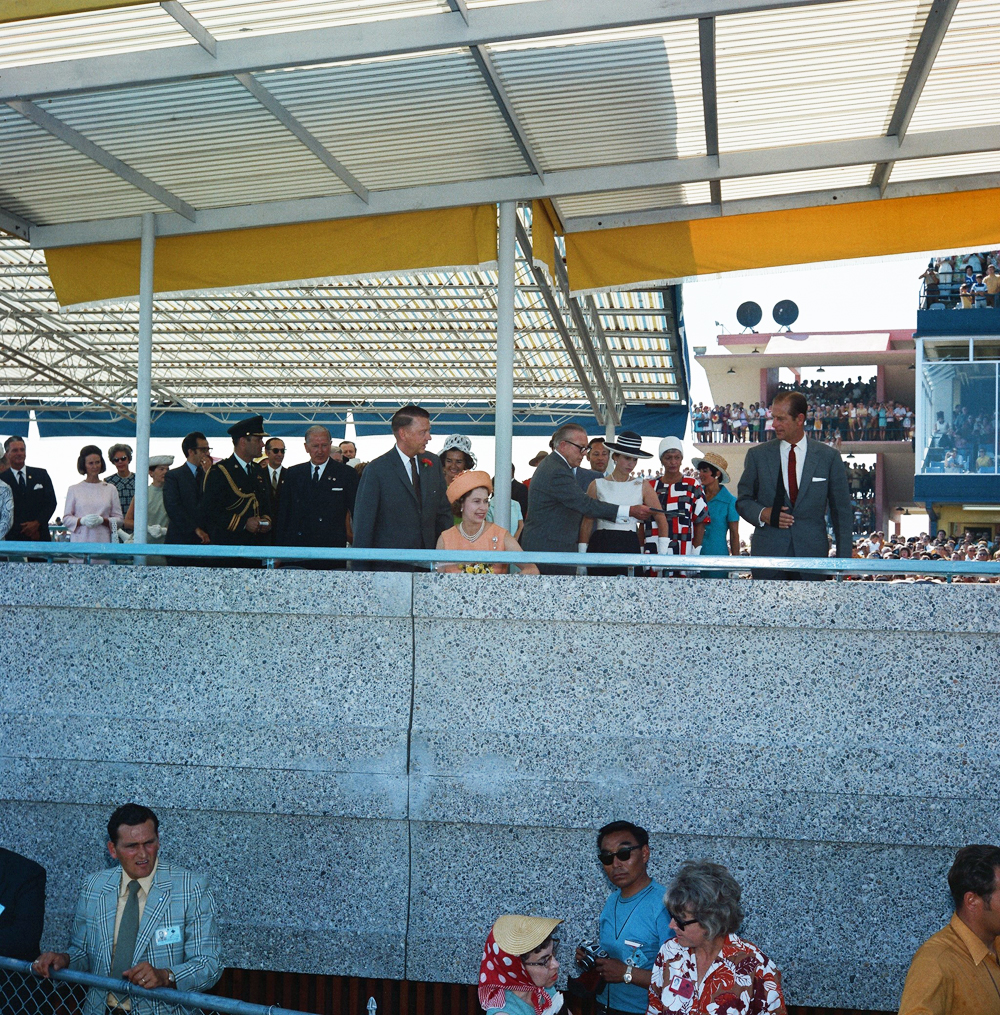
Royal viewing dais. 1970 Manitoba Derby.
The 1970 Derby attracted an interesting mix of entrants that spanned the spectrum of equine talent. The field had its fair share of well-bred quality runners. Of the 15 thoroughbreds entered in the 1970 Queen’s Plate, 14 were kept eligible for the Manitoba classic. There were some in the Derby field that just didn’t belong, but all subscription fees had been paid so they were permitted to run. The owners of the sure to be “also rans” saw an opportunity to partake in the once in a lifetime event and weren’t about to miss it.
Two local “hopefuls” were fine examples. Apairian had only won one race and Parade Square was still a maiden and worse, he had only ever beaten one horse. Of Parade Square’s chances, the Free Press graded selections comment said, “might get lapped.” How did they do? ell, Apairian was eased at the ½-mile pole and Parade Square was pulled up after a ¼-mile.
Jean-Louis Levesque’s entry of Fanfreluche with Ron Turcotte up, and Croquemitaine with local hero Bobby Stewart aboard, were sent postward as the race favourites. Fanfreluche was the only filly in the race and no filly had ever won a Manitoba Derby that had been held at the Downs. History awaited rider, Ron Turcotte, who would go on to ride the greatest horse of all time, Secretariat, to victory in the American Triple Crown races in 1973.
The Derby was run on a rare holiday Wednesday afternoon card and one of horse racing’s greatest of equalizers, heavy rains fell on Tuesday. The track went from muddy to a dreadful, drying racing strip that was classed as “heavy.” Formal racing terms aside, the track was just down right gnarly. Regardless of the racing surface, the only lady in the field, Fanfreluche stayed out of trouble and raced just off the pace. She took command coming out of the final turn and according to the official form chart “retained a good advantage under left handed urging.”
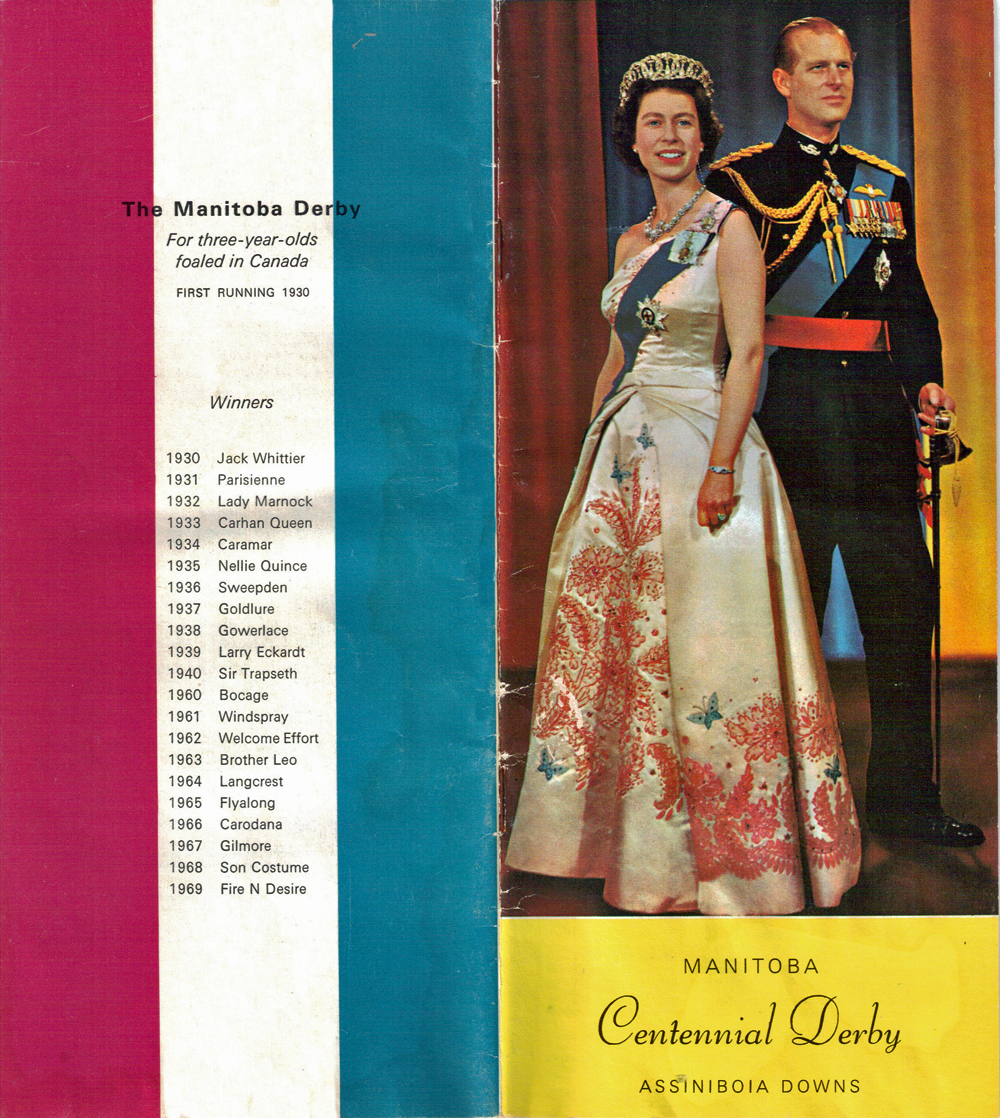
1970 Manitoba Centennial Derby Program. July, 15, 1970.
Did the winning connections have a secret weapon that day? You bet! Bobby Stewart, the rider of the other half of the entry, was said to have known our track “like the back of his hand.” In his post race interview Ron Turcotte was high in his praise for Stewart’s analysis of the track, and as a result Turcotte said he knew where the best footing could be found. He also paid tribute to Levesque’s magnificent filly. He acknowledged that the track wasn’t to her liking, but said she never gave up and dug deep to find more, “She’s all heart!”
A young trainer just breaking into the business, Glenn Wismer, from Brandon exercised Fanfreluche prior to the Derby. Glenn said she was a nice horse to gallop and had the smoothest stride of any horse he ever rode.
The $70,000 Manitoba Centennial Derby was the highlight of the Downs racing scene in 1970 and for years to come. Assiniboia Downs and President Jack Hardy were both recognized by the National Association of Canadian Race Tracks (NACRT) for the Royal Bash, and Hardy received a special achievement award from the NACRT at its annual banquet in Montreal.
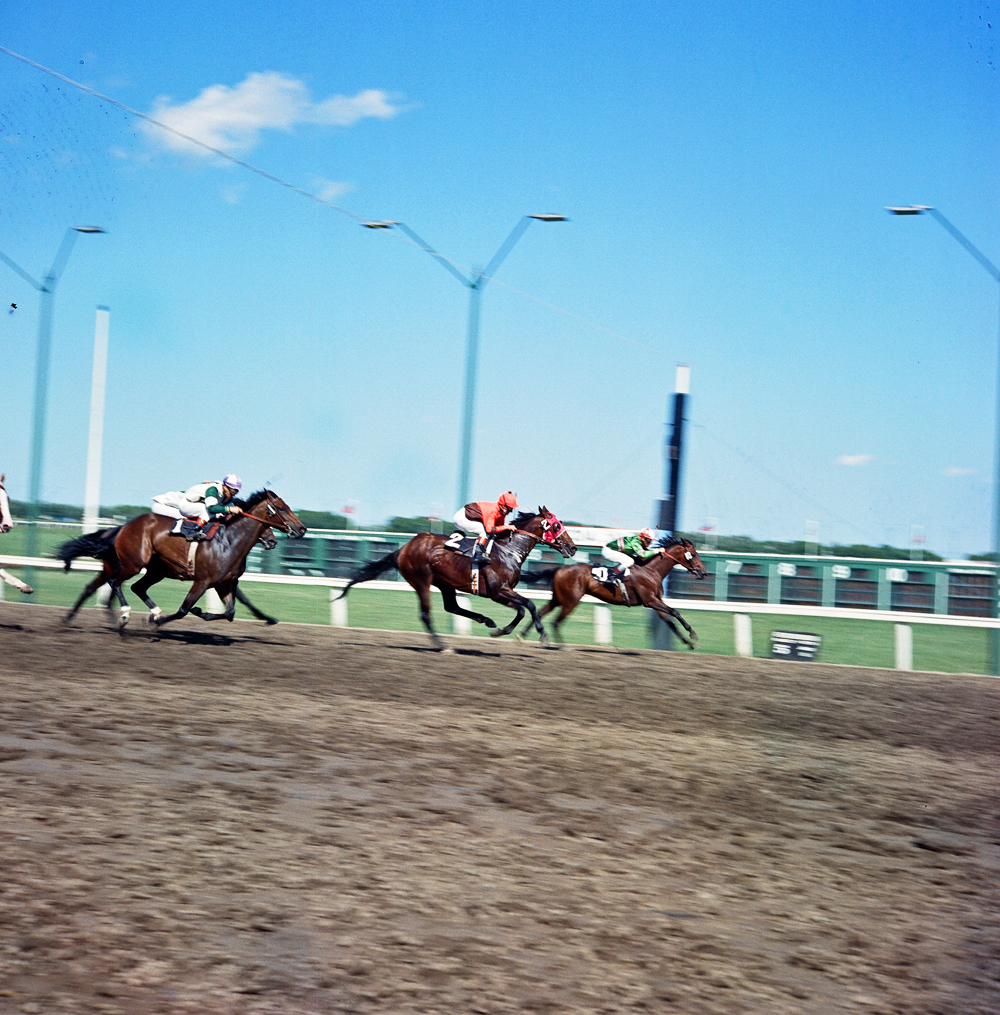
Longshot Apairian takes the early lead in the 1970 Manitoba Derby, followed by second choice Dance to Market. Winner Fanfreluche biding her time in third.
Manitoba Centennial Derby Trivia
— The Downs suspended all passes for the 1970 Derby. Advance general admission tickets were sold. The announced attendance figure totaled 11,127, the largest Manitoba Derby crowd ever.
— July 15, 1970 was the first and only time the Queen visited the Downs.
— The Centennial Derby, with its $70,000 guaranteed purse was at the time, the richest race ever run in Western Canada.
— The 14-horse field was the largest in Manitoba Derby history. A week before the Derby was run, 108 horses were still eligible for the race. The Downs only had a 12-horse starting gate, so arrangements were made with the Ontario Jockey Club to send two gates – a 6 and a 14-stall gate. The 1,200-mile trip took four days. The top speed of the convoy was 30 mph with the vehicles averaging five miles per gallon.
— Lost in all the Derby hubbub was jockey Jimmy Anderson’s fine riding performance that Wednesday afternoon. Jim rode three winners, including both ends of the daily double and had a second-place finish to boot.
———————————————————————————————————-

1970 Manitoba Derby winner Fanreluche.
Most normal stories would end here, but Fanfreluche had more drama waiting for her.
She was retired after the 1970 racing season. She’d won 11 of her 21 lifetime starts and hit the board an astonishing 19 times in her two-year career. In 1970 the multiple-stakes winner was named Horse of the Year and Champion 3-Year-Old Filly.
In June 1977 Fanfreluche was “horse-napped” while at Claiborne Farm in Kentucky. At the time she was in foal to Secretariat. Some six months later she was found 150 miles away on another Kentucky farm. The innocent owners of that farm reported that they had found the mare running loose on the highway and took her in and named her Brandy.
Relatively unscathed from the incident, other than needing a good grooming, she was returned to Claiborne where she gave birth to “Sain et Sauf” which translates to “Safe and Sound.” William Michael McCandless was later convicted of stealing the mare.
Fanfreluche was sold as a broodmare prospect shortly thereafter for a record $1.3 million. Her breeding shed suitors included Honest Pleasure, Buckpasser, Mr. Prospector and Alydar and she was bred to Secretariat five times.
Once her mothering years were done, Fanfreluche spent her days with her pasture mate, Optimistic Gal. In mid-July 1999 Optimistic Gal passed away. A few days later, Fanny, as she was affectionately known, passed as well, at the ripe old age of 32. It’s hard to say whether she missed her old friend or if it was just her time? The two old gals were buried together at Big Sink Farm in Kentucky.
The colour and pageantry of the Manitoba Derby made it the greatest event that has ever or will likely ever be held at Assiniboia Downs. The French filly was at her best that day and there to greet her at the finish was the Queen of England. On July 15, 1970 at Assinboia Downs…
It was the two ladies who reigned supreme!
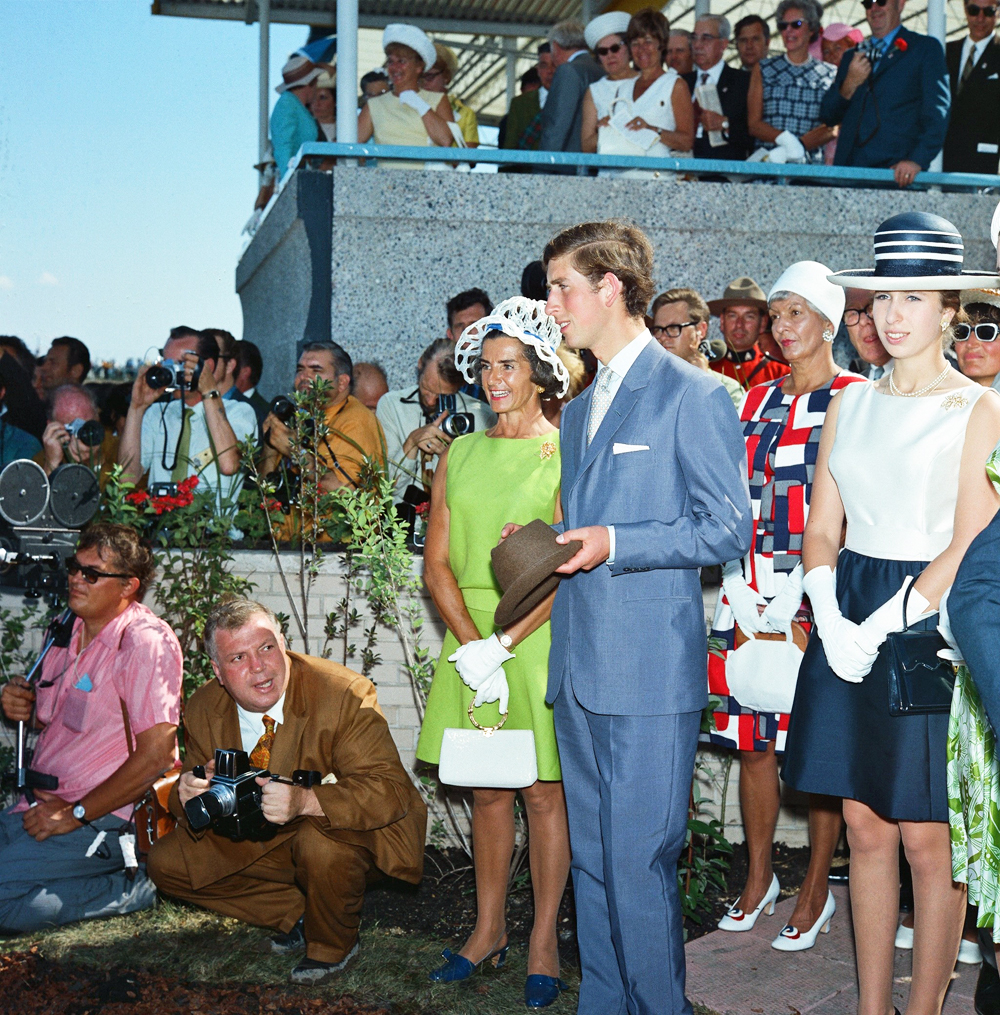
Future King Prince Charles and Princess Anne, at Assiniboia Downs in 1970.
